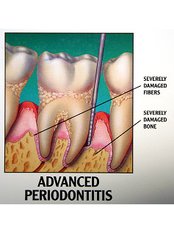Periodontitis Treatment

In the broadest sense, periodontal disease can be considered any form of disease affecting the periodontium - the tissues that surround and support the teeth. Inflammation of the bone is called periodontitis.
The periodontium also includes the gums (or gingiva), the bone of the tooth socket, and the periodontal ligament - a thin layer of connective tissue that holds the tooth in its socket and acts as a cushion between tooth and bone.
Inflammation or infection of the gums is called gingivitis. If allowed to progress, gingivitis can turn into periodontitis, the invasion and destruction of the underlying bone that anchors the teeth in place. As that happens, the gums may recede, exposing the root surfaces and increasing sensitivity to heat and cold. Teeth may even loosen because of bone destruction.
In the earlier stages of the disease, most of the treatment involves root planing and curettage (cleaning) under the gum margins. It involves the removal of plaque and inflamed soft tissue in the pockets around the tooth with an instrument called a curette. Its purpose is to remove the bacterial colonies and the mechanical and chemical irritants that cause inflammation in hopes that the disease can be eradicated. The goal is that the gum will reattach itself to the tooth or will shrink enough to eliminate the pocket.
In most early cases, root planing, curettage, and proper daily plaque removal are all that are required for a satisfactory result.